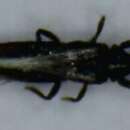en
names in breadcrumbs


Hoplandrothrips[1](commonly misspelled as Hoplandothrips[2]) is a genus of thrips in the Phlaeothripidae family.[3] Some species are recorded as pests on coffee growing in East Africa, causing a distinctive rolling of the leaf.[2][4] The genus was first described in 1912 by J. Douglas Hood.[1][5]
Adults are dark brown and around 2 mm long and the larvae are pale yellow.[6] In coffee, they feed on young leaves causing them to roll very tightly, reducing the photosynthetic area of the leaf. They tend to cause little loss in yield however compared to coffee berry borer and antestia bugs.[2]
Hoplandrothrips(commonly misspelled as Hoplandothrips) is a genus of thrips in the Phlaeothripidae family. Some species are recorded as pests on coffee growing in East Africa, causing a distinctive rolling of the leaf. The genus was first described in 1912 by J. Douglas Hood.
 Leaves on a coffee tree that have rolled up due to Hoplandrothrips
Leaves on a coffee tree that have rolled up due to Hoplandrothrips